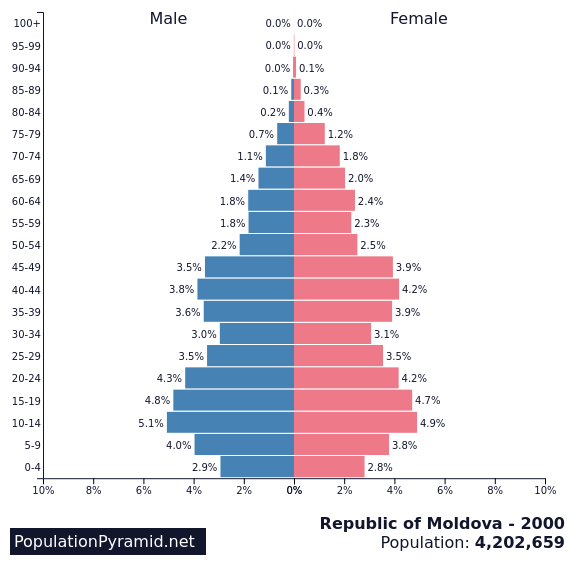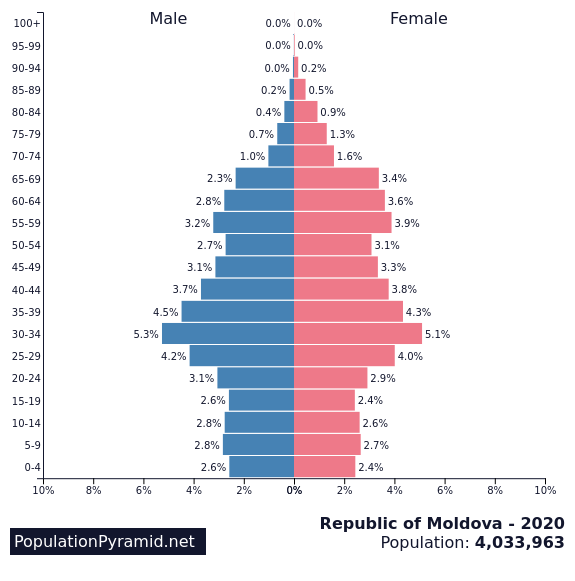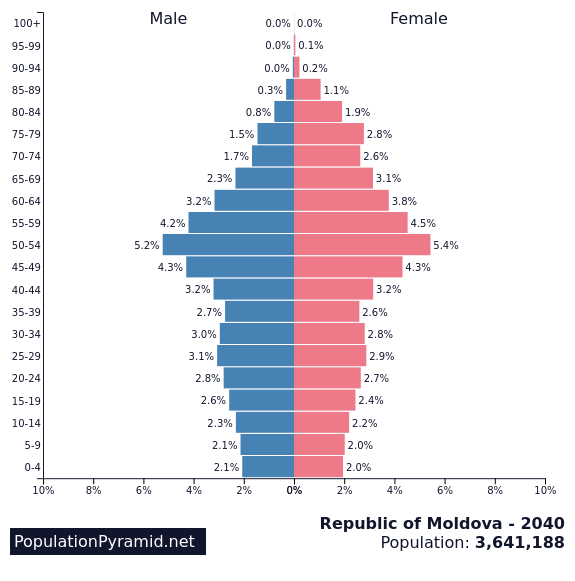The Republic of Moldova is a small eastern-European country that used to be a part of the Soviet Bloc. Its population reached its peak during the year 1990, prior to the collapse of the Soviet Union, and has been in the process of a steady decline since. According to Population Pyramid (b), the population of Moldova is at 4,033,936 people, having lost a net total of 330,000 citizens since the collapse of the USSR. The country’s life expectancy is at 71.63 years in total, with a few years fewer for males, and a few years more for females (Cash 93). Moldova’s birth rate is 10.57 children per 1000 individuals (Cash 93). Death rates are at 12.6 deaths per 1000 people, showing a negative dynamic (Cash 94). The population pyramid of the country during the year 2000 is as follows (Population Pyramid (a)):

As it is possible to see, the number of people of child-bearing age and pre-child-rearing age are the majority, promising a potential growth for the country’s population. The only drop is seen among the individuals of years between 25 to 34, which is understandable considering that 10 years ago the country suffered a crisis, surviving the aftermath of the collapse of the USSR (Cash 91). However, these are not the only factors that affect population rates. In 2020, the population dynamics are as follows (Population Pyramid (c)):

As it is possible to see, the number of people in the first third of the pyramid shrunk considerably, with the biggest quarter of the population currently found in other parts. It promises a continued shrinkage of the population in Moldova. The projected parameters for the year 2040 are even bleaker, with the population aging rapidly, and the younger people becoming fewer and farther between:

The shapes of pyramids are different from those of the US for two major reasons. The first is that the population dynamic is negative – there are more deaths than births in Moldova, whereas the US shows a marginal increase from year to year (Cash 95). Second, Moldova has a very high migration rate, whereas the US is a country many people migrate into. Moldova’s current migration rate is at -0.344 per 1000 population as of 2020 (Cash 98). The reasons for such trends include the economic stagnation of the country, inept leadership in the past 30 years, and the open-border policy with the EU, of which Moldova is an associated member of (Cash 99). These trends make it very easy for the younger populations to migrate in search of a better life. The people most likely to migrate to Europe in search of work and better opportunities include those aged between 20-35, whereas older populations often find work in countries like Ukraine and Russia (Cash 99). These factors, combined together, explain the trends as they are demonstrated in the population pyramid.
Moldova is in no danger of overpopulation, as the number of citizens occupying the country is projected to decrease by roughly 350,000 people by the end of 2040 (Population Pyramid (c)). The negative birth-to-mortality dynamic is explained not by the standards of medicine and child-rearing (these parameters are acceptable and not much lower than in the rest of Europe) but rather by the propensity of young people to migrate (Cash 91). They are less likely to conceive more than a single child either, due to not being able to support them domestically. Unless the country goes through an economic renaissance in the next 20 years, transforming its living standards to those of Finland, Germany, or Italy, the trend is likely to continue as predicted.
References
Cash, J. R. (2020). A Nation of United Villages? Demographics and identity in Moldova since independence. Balkanistichen Forum, (1), 90-101.
Population Pyramid (a). “Republic of Moldova 2000.” PopulationPyramid.net, 2021. Web.
Population Pyramid (b). “Republic of Moldova 2020.” PopulationPyramid.net, 2021. Web.
Population Pyramid (c). “Republic of Moldova 2040.” PopulationPyramid.net, 2021. Web.